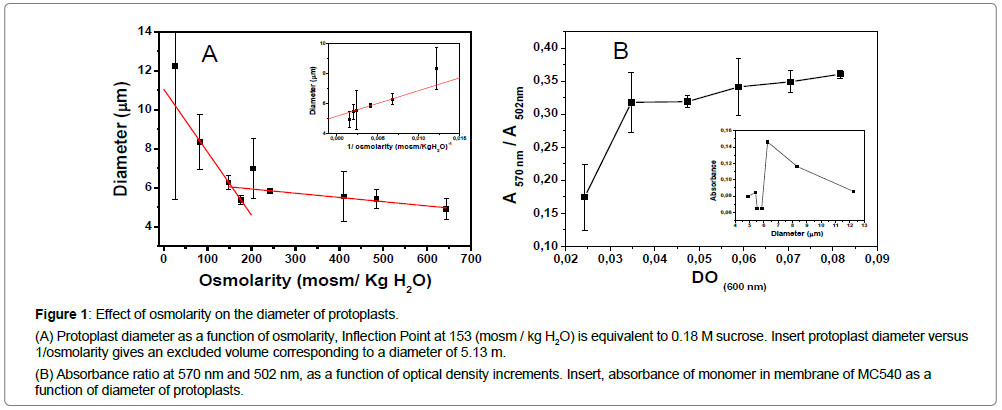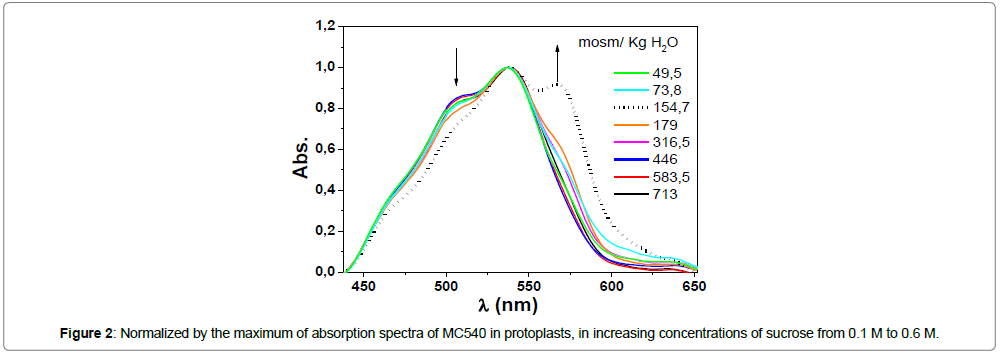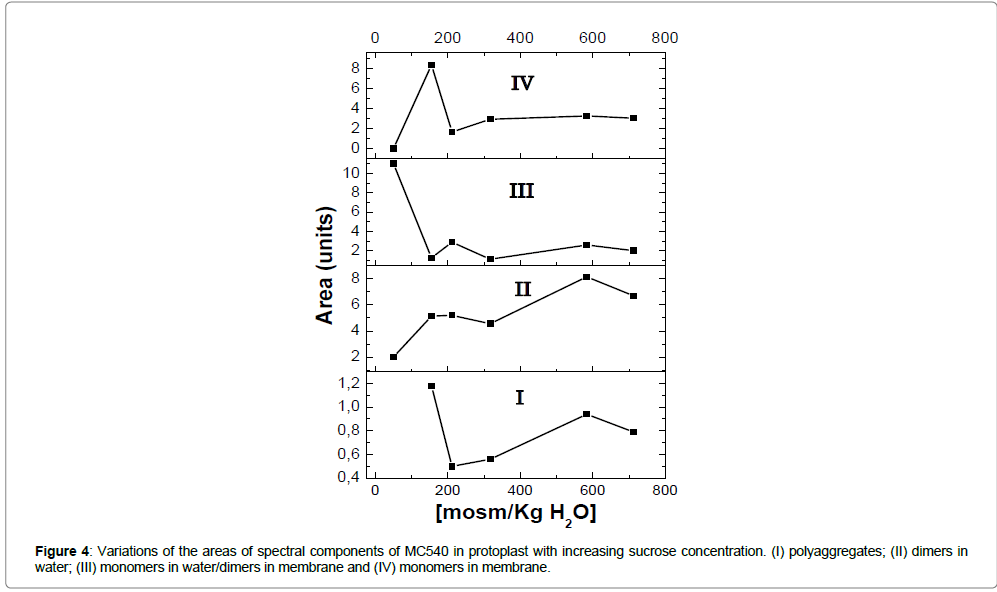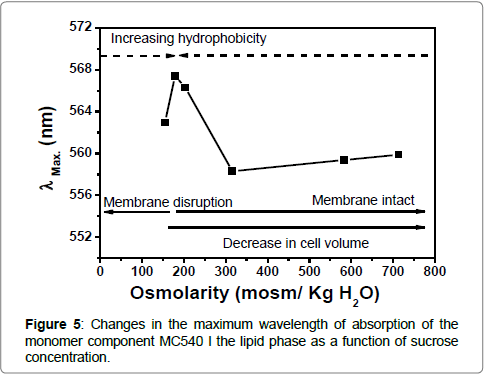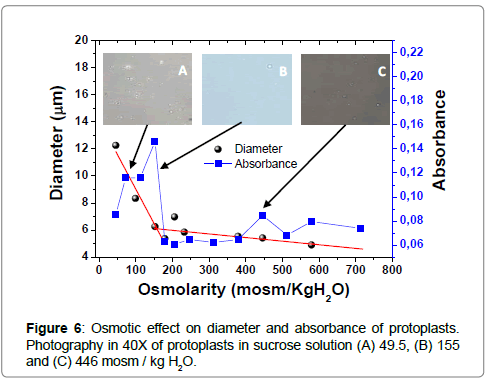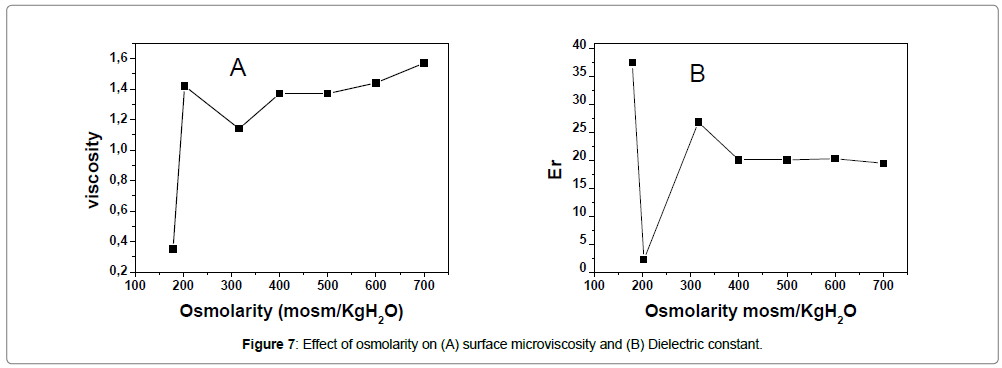Research Article, Vegetos Vol: 30 Issue: 4
Effect of Osmotic Stress on the Surface Properties of Protoplasts as Measured by Merocyanine 540
Pablo M Sain1,2, Silvia Rodríguez2 and Edgardo A Disalvo1*
1Laboratorio de Biointerfases y Sistemas Biomiméticos
2Laboratorio de Ciencia y Tecnología de Alimentos, Centro de Investigaciones y Transferencia de Santiago del Estero (UNSE-CONICET) RN 9, Km 1125, Villa El Zanjon, CP 4206 Santiago del Estero Argentina
*Corresponding Author : Edgardo A Disalvo
Laboratorio de Biointerfases y Sistemas Biomiméticos
E-mail: disalvoanibal@yahoo.com.ar, pablosain28@ hotmail.com, silviadepece@hotmail.com
Received: August 28, 2017 Accepted: September 11, 2017 Published: September 14, 2017
Citation: Sain PM, Rodríguez S, Disalvo EA (2017) Effect of Osmotic Stress on the Surface Properties of Protoplasts as Measured by Merocyanine 540. Vegetos 30:4. doi: 10.5958/2229-4473.2017.00194.X
Abstract
Protoplasts isolated from arugula leaves show the appearance of hydrophobic regions in the surface when cell volume is increased as detected using by Merocyanine 540 (MC540). The analysis of the equilibrium of the dye species indicates that MC540 monomers and dimers distribution varies at each osmotic stage. It is suggested that this is a consequence of the changes produced in the surface packing at the membrane level, due to the affinity of this dye with lipid environments, which could be important for the interaction of enzymes and other solutes produced by plants during hydric stress.
Keywords: Osmotic stress; Protoplast; Interfacial properties; Merocyanine 540
Introduction
The process of preservation of vegetable foods as leaves in cold storage produces a loss of water. This can be ascribed to changes in the permeability of the cell membrane due to a combination of factors such as, disfunction of water channels (aquaporins), modification of the ionic transport by specific enzymes, presence of ROS that affects the lipids [1]. There are also second and third messengers, like EROS and Ca+2 involved in the induction of expression of genes of interest in response to stress [2]. The hydric, osmotic and thermal stresses involve modifications in the flows of Ca+2, H+, Cl- and K+ ions in addition to water loss, in response to hormonal signals translated by specific receptors found in the plasma membrane and cytoplasm. The activities of pumps and channels driving those ions modify the polarization of the plasma and vacuole membranes [3]. This may involve water exchange across the membrane affecting the membrane potential. In this regard, the action of hydric stress can be visualized in two aspects. In one of them, water can go in and out through the membrane when cells are subjected to hypertonic or hypotonic solutions.
The other is that osmolytes alter the water environment of the lipids in the membrane itself causing defects of packing and topological failures. Specifically this last process may change the surface properties of membranes affecting the sites for biological compounds such as amino acids and peptides [4]. These effects may be of relevance in membranes of cells of food leaves subjected to hydric stress during preservation and storage processes. In spite that there are a considerable amount of work done in lipid model systems, in which different types of water has been identified around hydration sites of phospholipids, to the best of our knowledge, surface properties of protoplast in relation with the membrane changes produced in the process of osmotic stress has not been evaluated [5].
For this reason, the purpose of this work is to characterize the changes in surface properties originated in the plasma membrane by osmotic stress using the dye MC540, a probe that is highly sensitive to environmental polarity and viscosity changes [6].
Vast information on the interaction of MC540 with model membrane systems as liposomes and vesicles and the structural changes in lipid membrane packing is available.
Different species of MC540 as dimers and monomers may partition between water and membrane phase [7]. It is shown that the absorption spectrum of merocyanine 540 in the presence of artificial vesicles changes from an aqueous spectrum to a spectrum more similar to that of the dye in hydrophobic solvents, when the temperature rises through the phase transition temperature [8]. In addition, it is observed that as the bilayers cross their phase transition, a series of changes in their properties take place. The viscosity of the bilayer decreases, the membrane expands laterally, contracts transversely, and the movement of the side chain of the fatty acid increases, while the arrangement and semi-crystalline closed packing of the head groups disappear. Fluid phase bilayers bind merocyanine 540 monomer strongly, while gel-phase membranes do not [9].
MC540 may also report changes in polarization of very small cells. This dye has been widely applied in monitoring the transmembrane potential in biological samples. Measures of the fluorescence emissions of individual cells stained with MC540 was useful to detect changes in membrane potential in plant cells, for cell sorting purposes, for the identification of resistance in apple germplasm. In addition, the functions of toxic metabolites from pathogens and to determine the metabolite action on the membrane have also been reported [10]. However, studies about the interaction of the probe with plant cells are scarce.
Therefore, it is of interest to study changes in the biophysical properties of surface microenvironments with this probe analyzing the behaviour of the different dye species involved in the equilibrium during osmotic stress. In this work, a detailed analysis of the interaction of various species of MC540 with plasma membrane of protoplasts isolated from arugula is proposed in order to follow structural changes in the cell surface during osmotic stress. Also, the specific damage of osmolytes is also investigated.
This analysis may be of importance to predict changes in the state of the crop under certain conditions, caused by biotic and abiotic stresses.
Experimental
Plant culture
Arugula plants, variety Eruca Sativa Mill were cultured using a commercial hydroponics system (Hidroponía Cáceres Hnos, Concordia, Entre Ríos, Argentina) with specific nutrient solution for vegetables. The seeds were germinated in foam phenolic during two weeks, and then are transferred to the culture system for growth and subsequently harvested for the protoplast extraction.
Protoplast preparation
Eruca Sativa Mill protoplasts were isolated mechanically from leaves performing a scraping stem in hypertonic sucrose solution 0.6 M in order to avoid damage to the membrane and cell wall. After plasmolysis, protoplasts were filtered through a 100 μm stainless steel mesh to retain traces of plant tissue and then dispersed in hypotonic solution of sucrose in order to release the protoplasts. The suspension was centrifuged at 4500 rpm for 5 min and the pellet resuspended in solution of interest.
Osmotic stress solutions
Osmolarity and concentrations are listed in Table 1. Dye- Free protoplast suspensions were used as reference to compensate turbidity effects. Spectra were obtained in a sample 2 ml of protoplast suspension with an optical density (OD) at 600 nm. Then 100 ul of 100 uM aqueous solution MC540 was added to all suspensions and incubated for 30 minutes.
| Concentration sucrose (M) | Osmolarity sucrose (mosm/Kg H2O) |
Concentration MC540 in the cell. |
|---|---|---|
| 0,10 | 49 | 47,6uM |
| 0,12 | 54 | 47,6uM |
| 0,18 | 148 | 47,6uM |
| 0,20 | 176 | 47,6uM |
| 0,30 | 335 | 47,6uM |
| 0,40 | 485 | 47,6uM |
| 0,50 | 634 | 47,6uM |
| 0,60 | 793 | 47,6uM |
Table 1: Different concentrations of sucrose prepared with concentrations and osmolarity.
Osmotic shocks
The osmotic stress was induced by different concentrations of sucrose prepared with concentrations and osmolarity listed in Table 1. The osmolality was determined using an osmometer Loser brand Typ M 10 / 25 μl.
Spectroscopical methods
Merocyanine õ = 0.6 x 105 M−1. cm−1 from Sigma Chemical Co. was used as a probe for the spectroscopic characterization of the protoplast surfaces subjected at different osmotic stress. Stock solutions of MC 540 were prepared in the distilled water and stored at 50C. All dye preparations were wrapped in aluminium foil and kept in the dark whenever possible. Aliquots of 100 ul MC540 aqueous solution were added to 2 ml protoplast solution of OD at 600 nm, in glass cuvettes of 1 cm path length. Spectra as those in Figure 4 were taken after incubation for 30 minutes. To study the effect of osmotic stress, protoplasts were suspended in different sucrose concentrations and MC540 spectra were obtained in a Jasco V-630 double-beam spectrophotometer.
The peaks and baseline function of the origin software version 8.0 SR3 performs fitting multiple peaks were obtained by deconvolution using the Gaussian function.
The fitting is based on the non-linear curve-fitting module in Origin. The multiple peaks were fitted as the accumulation of Gaussian function. The peak area is determined as the integral between the limits of the absorbance bands. It corresponds to the normalized spectra MC540 at increasing osmolyte concentration. No spectral changes of dye were observed with increasing sucrose concentration, therefore there is no interaction of the probe with the osmolyte.
Microscopic observations
The protoplasts were incubated 10 minutes, before measuring diameters by microscopy in a microscope OLYMPUS CKX41.
Results
Spectroscopic properties of MC540 in protoplasts
The protoplasts were collected at 446 mosm / kg H2O of sucrose. After centrifugation, the supernatant was removed and the protoplasts suspended in solutions of different osmolarities. The changes of cell size after one hour of incubation at each sucrose concentration are shown in Figure 1. In the range between 200 a 650 mosm/ Kg H2O, an attenuated volume decrease is observed with osmolarity as reported previously by Ohshima [11].
Figure 1: Effect of osmolarity on the diameter of protoplasts.
(A) Protoplast diameter as a function of osmolarity, Inflection Point at 153 (mosm / kg H2O) is equivalent to 0.18 M sucrose. Insert protoplast diameter versus 1/osmolarity gives an excluded volume corresponding to a diameter of 5.13 m.
B) Absorbance ratio at 570 nm and 502 nm, as a function of optical density increments. Insert, absorbance of monomer in membrane of MC540 as a function of diameter of protoplasts.
The inflection point found at 175 mosm/ kg H2O suggests a change in regime of water fluxes, i.e. at least two different water compartments. One would correspond to free water in the cell volume and the other to water compromised with cell structures such as membranes.
An excluded volume corresponding to 5 um diameter can be obtained by extrapolation to zero of the inverse of the osmotic pressure (Figure 1). This excluded volume would correspond to cell structures (membranes and macromolecules) with its corresponding hydration shells (non-osmotic water). Changes in surface membrane properties around this point are analysed next by the inspection of the MC540 spectra.
The 570 nm and 500 nm absorbance ratio increases to reach a constant value above OD 0.035, denoting that the protoplast surface is saturated with the dye at this OD (Figure 1B). Therefore, the variation in the absorbance ratio as a function of the conditions that may affect the protoplast membrane was studied in this OD range.
Characterization of surfaces changes of cells under osmotic stress
The effect induced by osmotic pressures produced by sucrose as osmolyte on the surface of protoplasts is followed by the spectral changes of MC540 in (Figure 2) Increasing sucrose concentrations promote the appearance of a shoulder at 570 nm and a decrease in the peak at 504 nm in the range of 49.5 at 154.7 mosm/Kg H2O.
The effect is better observed in the plot of (Figure 1B) where the 570 nm absorbance is compared with the diameter change for different osmolarities as described in appendix 2.3 and 2.4. The absorbance at 570 nm increases at around 6 um and decreases monotonically when cells swell.
Thus, changes in absorbance at 570 nm indicate that cellular volume changes caused by osmosis affect membrane surface at different stages. This could be related to different topological changes produced by compression, such as, curvature and partial dehydration. In order to have an insight of these possibilities the MC spectra components are analysed next.
Spectral decomposition and polarity changes
Absorbance at 570 nm is characteristic of monomer of MC in lipid phases in the liquid crystalline state [8]. The maximum area for this absorbance band appears at 149.5 mosm/kg H2O at which the cell diameter is 6.26 μm. Thus, it suggests that under these conditions monomers of the dye may adsorb to hydrophobic sites of the protoplasts at the interface. This behaviour have been described previous in lipid model systems and ascribed to the formation of defects of packing in the membrane interphase due to the induction of curvature [12].
Similarly, in protoplast, monomers inserted in membranes may be perturbed by the osmotic state. This is to say that the equilibrium of dye species is modulated by the packing and hydration state of the membrane. Previous results support this conclusion as discussed by Bernik and Disalvo [7]. Deconvolution of spectral changes of MC540 absorbance produced by osmotic pressures above the inflection point of 149,5 mosm/ kg H2O is shown in Figure 3.
At different osmotic states, protoplasts show different distribution of dye species. The absorbance at 450, 500, 530 and 570 nm corresponds to the following different dye species, respectively: (I) polyaggregates in water; (II) dimer in water; (III) dimer in membrane and monomer in water; (IV) monomer in membrane [5].
The evolution of the peaks in Figure 3 with concentration are shown in Figure 4. In this concentration range, the cell diameter slightly varies and a gradual decrease of the monomer in membrane (band IV) is observed in parallel to an increase in area of the band corresponding to the dimer in aqueous phase (band II). The formation of this band depends on the balance monomer/dimer and serves as a control to detect any significant amount of dye in water.
A conversion of monomers to dimers in aqueous media (band IV and band II) is observed with increasing sucrose concentration. It is known that MC540 dimer increases with density packing of phospholipids [5].
The formation of dimers in solution (band II) is stimulated by the lipid packaging and by the increase in the density of charge per unit area. This facilitates aggregation and formation of dye polyaggregates. Finally, species (I) is favored in polar microenvironments where the surface charge density increases as a result of the phospholipid packaging. Similar effects were observed in studies of lateral diffusion of phospholipids, which is an important phenomenon in the dynamics of membranes [8].
The (band IV) corresponding to monomer in membrane is especially sensitive to changes in polarity. Increases in solvent polarity produces hypsochromic shift in the band monomer in lipid phase.
This solvatochromic behavior of the dye was shown by Miller and Chorvat over a wide range of dielectric constants solvents [8,13,14]. Therefore, it is of interest to study the surface properties around the range of 150 mosm/ Kg H2O and in the transition zone, to characterize effects caused by stresses on the cell surface.
An increase in polarity is observed above 200 mos/ Kg H2O of sucrose, with the decrease in diameter of protoplasts (Figure 5).
The higher curvature of the smaller protoplasts and the increased surface phospholipid density due to osmolarity increase the surface polarity in the region above 200 mosm / kg H2O of sucrose, Facilitating the access of water molecules due to loss of surface hydrophobicity.
In this environment the dye affinity for the cell surface decreases, accompanied by a hypsochromic change of the monomer band in the lipid phase, similar to the behavior observed in vesicles [9]. On the other hand, the maximum area corresponding to the membrane monomer absorbance band Figure 4 (IV) corresponds to the maximum wavelength shift. This justifies monomer binding at the interface as the surface becomes more hydrophobic and indicates the potential of the probe to evaluate the polarity of microenvironments using the shift in the wavelength of the monomer species of the dye. In the Figure 6 shows that cell rupture occurs at osmolarities below 175 mosm / kg H2O and the osmotic effect on cell diameter as well as membrane monomer absorption is compared.
The spectral change of MC 540 around the band of 570 nm may be taken as indicative of preferential binding of MC monomer to expanded phase bilayers, where most of the molecules acquire the characteristic absorption spectrum of the molecules in a hydrophobic environment.
Changes in the molecular packing at the surface of the bilayer are responsable for the affinity difference of MC 540 monomer.
Osmotic effects on viscosity and dielectric constant
The use of solvatocromic dyes as indicators of solvent polarity has been extensively revised [14 ,15,16]. In this context, solvent dependent MC540 absorptions were studied as possible reference processes to establish empirical scales of polarity, viscosity and solvent dielectric constants [17]. With the objective of establishing relations between the solvatochromism of the dye inserted in the lipid phase and the superficial changes induced in protoplasts against effects of osmotic stress. In this way valuable empirical information is obtained from the surface interface. In (Figure 7A) a slight and gradual increase micro viscosity depending osmolarity in the region 200 is observed at 700 mosm/Kg H2O. The abrupt change that distinguishes below 200 mosm / Kg H2O is due to the loss of the lipid organization due to turgor effect and subsequent plasmolysis. Therefore, we can state that the membrane remains stable to viscosities of about 1.4 similar to solvents such as ethanol. In (Figure 7B) the minimum dielectric constant value reflects that under these conditions the monomer is inserted in a hydrophobic environment with intermediate electrical properties between dioxane and octanol. For these observations a control experiment was carried out in which the dye absorption in the range of working osmolarities was measured and no change in the spectra was observed. These results indicate that small variations in viscosity produce large electrical disturbances at the interface.
Discussion
It is found that osmotic stress effects modify the surface properties of protoplasts of Eruca Sativa Mill. It is also shown that lipid expansion similar to that caused in the phase transition can be caused by changes in the osmolarity of the medium to which the protoplasts are subjected and that the main determinant of the interaction between the bilayer and MC540 is the state of packing induced by osmosis. The experiments performed provide information on the relationship between lipid packaging and cell surface polarity, which increases with decreasing cell volume. The packaging may produce topological changes and partial dehydration in the cell. This may be related to the formation of domains in the plasma membrane, which Merocyanine 540 detects in a variety of cells. This study emphasizes the importance of the possible functions of lipid domains in plant cell physiology. As under stress conditions could provide the favorable physical-chemical conditions to trigger multiple signaling processes. This work provides information of interest to project applied research in post - harvest technologies as well as studies of plant physiology using protoplasts as a model system and simple spectroscopic techniques. In the future it is projected to use the information obtained with the aim of sending and directing anti-aging compounds to the cell surface.
Acknowledgements
This work was supported with funds from CONICET (PIP 0484), UNSE (23/ A164), PIO CONICET 1452014010100010 and ANPCyT (PICT 2011-2606). EAD is member of the research career of CONICET (National Research Council, R Argentina). PS is recipient of a fellowship of CONICET.
References
- Reyes LF, Villarreal JE, Zevallos LC (2007) Food Chemistry 101: B1254-1262.
- Munemasa S, Hauser F, Park J, Waadt R, Brandt B, et al. (2015) Current opinion in plant biology28: 154-162.
- Zhu JK (2016) Cell 167: 313-324.
- Disalvo EA, Hollmann A, Semorile L, Martini MF (2013) Biochimica et biophysica acta, 1828, 1834-1839.
- Kaschny PF (1992) Goñi. Eur J Biochem 207: 1085-1091.
- Cunderlíková BL (2001) Sikurová. Chemical Physics 263: 415-422.
- Bernik DL, Disalvo E (1996) Inv Superior Retired. Chemistry and Physics of Lipids 82: 111-123.
- Lelkes PI, Miller IJ (1980) Perturbations of membrane structure by optical probes: I. Location and structural sensitivity of merocyanine 540 bound to phospholipid membranes. Membrane Biol 52: 1-15.
- Willamson P, Mattocks KR (1983) Schlegel, Biochimica et biophysica acta 732: 387-393.
- Mezzetti B, Zimmerman RH, Mischke C, Rosati P, Hammerschlag F (1992) Plant Science 83: 163-167.
- Ohshima Y, Iwasaki I, Suga S, Murakami M, Inoue K, et al. (2001) Low Aquaporin Content and Low Osmotic Water Permeability of the Plasma and Vacuolar Membranes of a CAM Plant Graptopetalum paraguayense: Comparison with Radish Plant Cell Physiol42: 1119-1129.
- Cutro AC, Disalvo E (2015) Phenylalanine Blocks Defects Induced in Gel Lipid Membranes by Osmotic Stress. The journal of physical chemistry B 119: 10060-10065.
- Mateasik A, Sikurová L, Chorvat D (2002) Interaction of merocyanine 540 with charged membranes. Bioelectrochemistry 55: 173- 175.
- Reichardt C (2003) Solvents and Solvent Effects in Organic Chemistry. (3rd edtn), Wiley-vch Verlag GmbH and Co. KGaA, Weinheim, Gemany.
- Baraldi I, Brancolini G, Momicchioli F, Ponterini G, Vanossi D (2003) Solvent influence on absorption and fluorescence spectra of merocyanine dyes: a theoretical and experimental study. Chemical Physics 288: 309-325.
- Mandal D, Pal SK, Sukul D, Bhattacharyya AK (1999) Photophysical Processes of Merocyanine 540 in Solutions and in Organized Media. J Phys Chem A 103: 8156-8159.
- Yavuz Onganer MY, Bessire DR, Edward L (1993)Quitevis. The Journal of Physical Chemistry 97: 2344-2354.
 Spanish
Spanish  Chinese
Chinese  Russian
Russian  German
German  French
French  Japanese
Japanese  Portuguese
Portuguese  Hindi
Hindi 